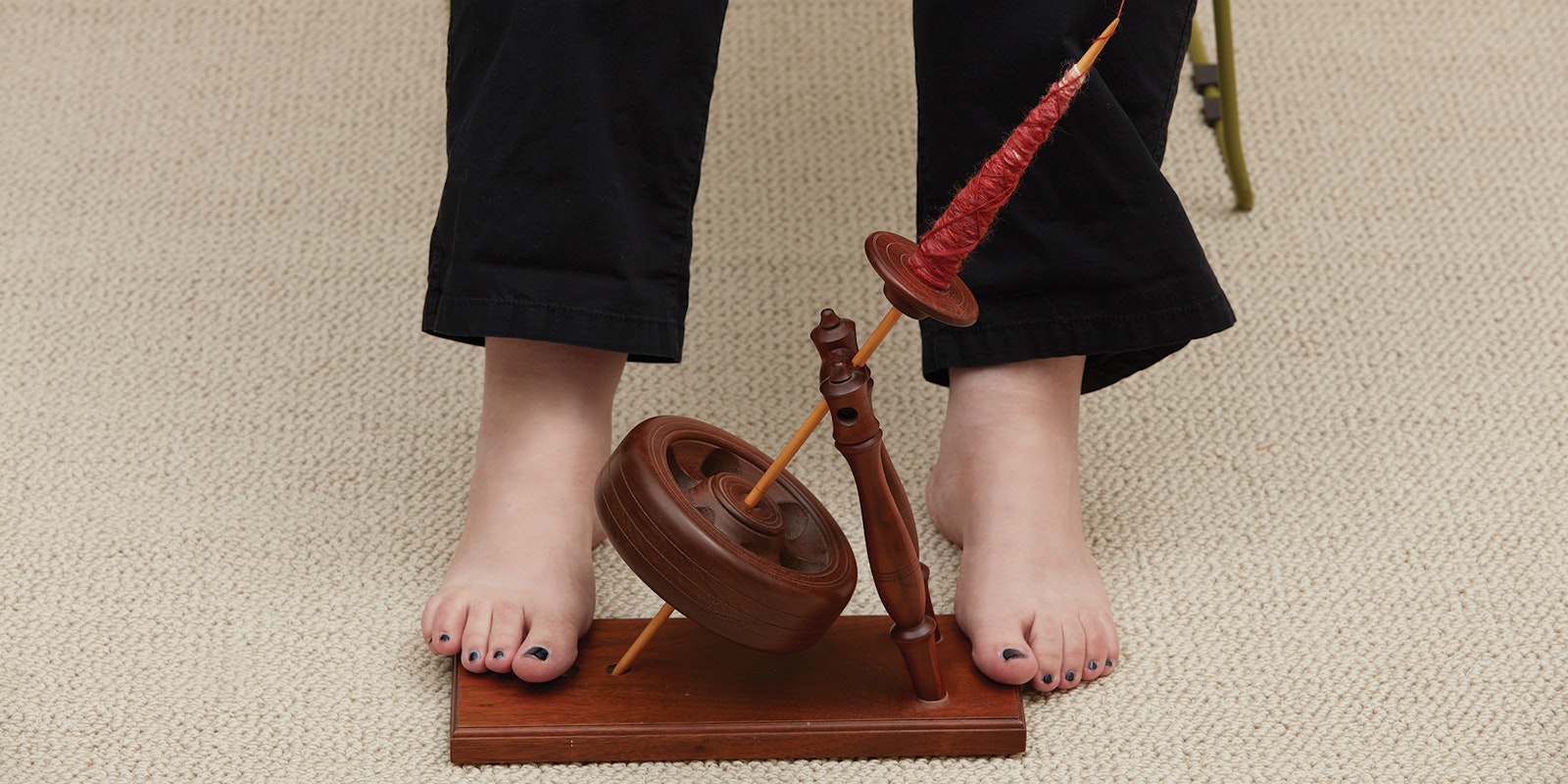Have you tried spinning on a kick spindle (or kick wheel)? In the Spin Off Fall 2016 issue, Carolyn Rivello introduces us to these versatile and portable wheels. They’re easier to use than you might think.
When seeing a kick wheel for the first time, everyone asks, “What do you call that?” The second question is, “How do you make it work?” It’s very simple.
Any kick wheel is driven in one of two ways: either there is room on the shaft extending below the wheel on which to place your foot, or you place your foot on the drive wheel itself. Attach a leader to the spindle and allow it to wind up the shaft. The leader should be long enough to wind up the shaft and have a few inches remaining past the tip. To start the wheel spinning, place the heel of your foot on the shaft or the drive wheel and draw it across from heel to toe and away, allowing the wheel to spin. Several “kicks” allow the wheel to gain momentum. Once the wheel is spinning, attach your fiber to the leader and begin drafting. Hold your fiber at about a 45-degree angle to the spindle tip while spinning.
 Turn the spindle by drawing the foot across either the wheel (as shown here) or the shaft below it. Depending on the configuration of the wheel, you might prefer to wear rubber-soled shoes.
Turn the spindle by drawing the foot across either the wheel (as shown here) or the shaft below it. Depending on the configuration of the wheel, you might prefer to wear rubber-soled shoes.
The next consideration when working on this kind of wheel is how to wind on. This is the major difference between spindle wheels and flyer wheels. Spinning on a flyer wheel is continuous; the yarn is drawn onto the bobbin as you work. In contrast, spinning on a kick wheel is intermittent, meaning that at some point, you must stop spinning and gather the already-spun singles onto the spindle shaft for storage.
When the length of spun singles is just about at the point where you can no longer comfortably draft, it is time to wind on.
To wind on, first allow the wheel to slow, then place your foot lightly on the wheel or shaft, letting friction bring it to a stop. Kick the wheel slowly away from you, and at the same time bring the spun singles in front of you and straight up, keeping the singles under tension as the yarn unwinds off the spindle shaft. Once you have the singles unwound back to the base of the spindle, stop the wheel again and begin turning it in the direction of your original spin, allowing the yarn to wind onto the shaft near the base of the spindle. Guide it with your right hand as you unwind, to help keep it under tension, and as you wind back on, so it winds on evenly. Create a cop the same way you would on a hand spindle. Make sure not to wind the entire length on, though—you will need some of the length to wind back up the shaft, with a few inches extra past the spindle tip for room to begin drafting again.
 To add twist to the yarn, hold the leader away from the tip at a 45-degree angle.
To add twist to the yarn, hold the leader away from the tip at a 45-degree angle.
Once your spindle is full, it’s time to wind off. If you’re going to make a plied yarn, you can wind the singles off into a ball and put it aside until you fill the spindle and wind off again, then ply from the balls. You can also wind off your singles with a ball winder and ply from both ends of the ball. Alternatively, you can wind off the singles onto bobbins from another wheel and ply from a lazy kate. Plying on a kick wheel is as easy as spinning on it. Just kick the wheel in the opposite direction.
 To build a cop, hold the yarn at a 90-degree angle to the spindle.
To build a cop, hold the yarn at a 90-degree angle to the spindle.
Three Tips for Spinning on a Kick Wheel
- Don’t use too much tension when spinning. You do not need to pull hard against the spindle tip. Spinning should be smooth and fluid. Relax and enjoy it, and speed will be a by-product.
- Depending what kind of kick wheel you have, it may help to wear rubber-soled shoes so your foot doesn’t just slip over the spindle shaft without actually turning it. You do need a bit of “grab” to get the wheel spinning. Bare feet and socks can slip, keeping you from getting a good spin with the least amount of effort.
- Place a small carpet square or a piece of nonslip shelf liner under the wheel for added stability.
Interested in learning about other types of spindles? This article and others can be found in the Fall 2016 issue of Spin Off.
Also, remember that if you are an active subscriber to Spin Off magazine, you have unlimited access to previous issues, including Fall 2016. See our help center for the step-by-step process on how to access them.
CAROLYN RIVELLO has been spinning for seventeen years. She holds a certificate from the Ontario Handweavers and Spinners Spinning Certificate Program and has taught and lectured at various local fiber festivals and spinning guilds. She lives in Rochester, New York, with her composer husband in a house full of wheels, fleeces, pianos, and music writing paper.
Originally published July 19, 2017; updated January 30, 2023.

